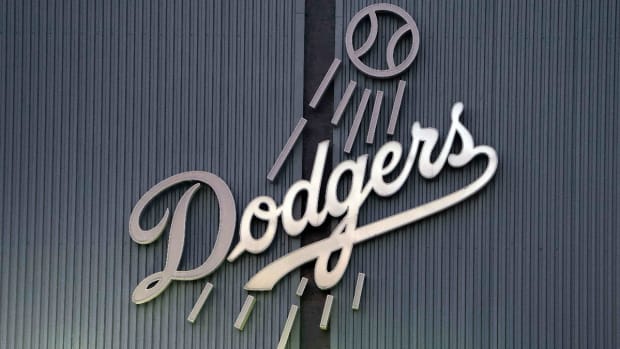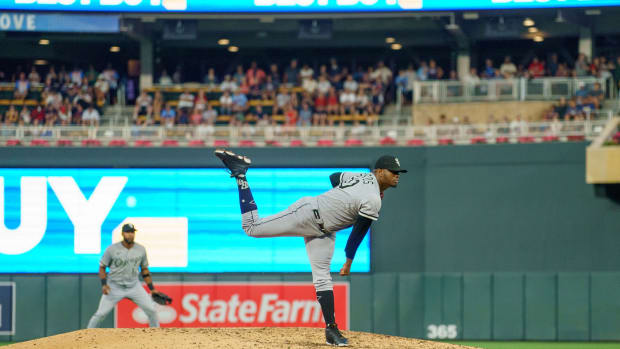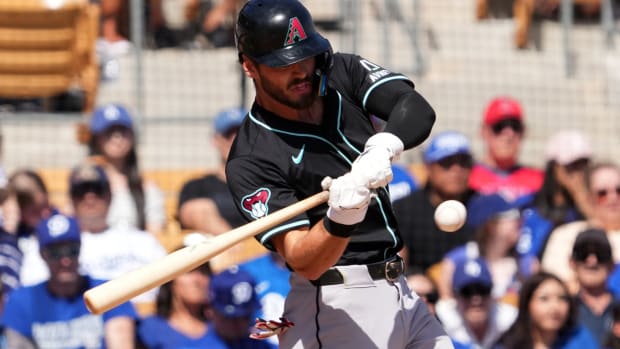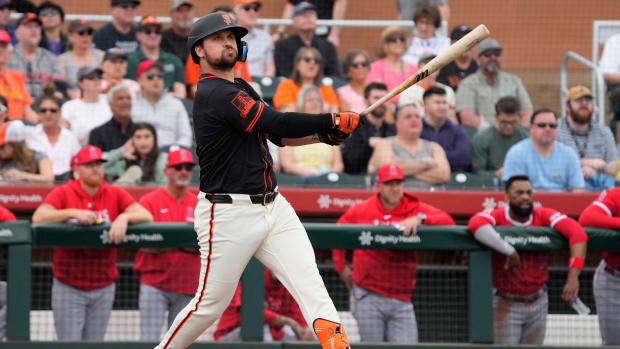Booms and Busts: Shortstop
Jimmy Rollins started to show his age in 2013, hitting just .252/.318/.348 on the year. (Matt Slocum/AP)
Late last month, I kicked off my second go-round of Booms and Busts, in which I highlighted a small handful of players at a given position whom I expect to take significant steps forward or backward. I have no hard-and-fast criteria for those players, no promises of fantasy league dominance or skyrocketing statistics for the Booms or slides below the Mendoza Line for the Busts. But between poring over projections, identifying players in changed circumstances such as trades, new roles, recoveries from injury, or entries into the prime age range of 26-29 years old, there are players I’d like to earmark before the season begins, for better or worse.
Note that I won’t be including rookies among these picks — those will be saved for another cycle — and I’m hoping (but not promising) that I won’t choose anyone from among last year’s picks. In the spirit of accountability, I’ll revisit those picks at each position, and see what I’ve learned (or haven’t); they’ll be judged on a PASS/FAIL basis as to whether I was right or wrong. Having covered the catchers and other infielders, it's time for a short stop before moving on to the outfield.
BOOMS
Jose Iglesias, Tigers:Stephen Drew's early-season injuries and Will Middlebrooks' struggles at the plate led the Red Sox to promote the slick-fielding Iglesias from Triple-A and find time for him at both shortstop and third base. Not only did the 23-year-old rookie put together an enviable highlight reel in the field, he rode a .376 batting average on balls in play to a .330/.376/.409 line with the Sox before being traded to the Tigers in a three-way deal on July 30. His bat inevitably cooled off, and he finished the year with a .303/.349/.386 line in 382 plate appearances, which helped him finish as runner-up to Wil Myers in the AL Rookie of the Year vote. Meanwhile, his reputation remained ahead of the metrics on defense, with both Defensive Runs Saved (dead even) and Ultimate Zone Rating (+3.4) regarding his work at shortstop as decent but not the AL equivalent of Andrelton Simmons. I don't expect him to be a league-average bat again, though I do think he'll outdo his .255/.294/.330 PECOTA forecast; furthermore, I expect that a full year at short for one team will bear considerable fruit, and we'll see him challenge for a Gold Glove.
Everth Cabrera, Padres: Cabrera had demonstrated his speed before by swiping a league-high 44 bases in 48 attempts in 2012, but he had only occasionally flashed his on-base skills prior to last season, hitting a combined .240/.321/.327 in 1,137 PA from 2009 through 2012. He got off to a strong start, hitting .305/.382/.418 and walking 32 times in 317 PA through the end of May, and wound up making the All-Star team. Alas, he was named in the Biogenesis investigation, and his season ended when he agreed to a 50-game suspension in early August. That's not good, obviously, but his year-end line (.283/.355/.381 with 37 steals) is something to write home about, particularly as both his BABIP (.337) and walk rate (9.4 percent) were essentially stable from the previous year while he made contact more consistently (his strikeout rate dropped from 24.5 percent to 15.9 percent) and cemented his spot atop the lineup. Look for the 27-year-old switch-hitter to pick up where he left off.
BUSTS
Alcides Escobar, Royals: Escobar had already turned some heads with his defense in his two-plus major-league seasons before breaking out with a .293/.331/.390 (96 OPS+) offensive showing en route to 3.5 WAR in 2012. Whatever gains he made, he couldn't maintain them in 2013; his BABIP slid from .344 to .264, and after seeing 3.73 pitches per plate appearance, he slipped to 3.48, plunging his abysmally low walk rate from 4.2 percent to 3.0 percent. In all, he hit just .234/.259/.300 for a 53 OPS+, and only solid defense (+4 DRS) prevented him from sliding below replacement level; his 0.3 WAR ranked 27th among the 34 shortstops with at least 300 plate appearances. At 27, he's young enough to rebound, but his career .258/.295/.342 line suggests his future is as a solid placeholder at best.
Jimmy Rollins, Phillies: A key component in the Phillies' run of five straight NL East titles from 2007-2011, Rollins has a whole mantle full of honors: four Gold Gloves, three All-Star appearances and the 2007 MVP award. But only twice in the past five years has he been more or less league average with the bat (2011 and 2012, with OPS+ marks of 101 and 98, respectively), and he fell off considerably in 2013, batting just .252/.318/.348 for an 85 OPS+; his home-run total dropped from 23 to six. His work in the field continued to suffer as well, at least according to Defensive Runs Saved; after being a combined 15 runs below average in 2011-2012, he was 15 below average last year, though to be fair, Ultimate Zone Rating saw him as tolerable (-2.7). His DRS-driven WAR was just 0.2, and for the past five years, he's averaged just 1.8. As he enters his age-35 season, I just don't expect him to be a significant asset anymore.
Last Year's Booms (graded Pass/Fail):
• Stephen Drew, Red Sox: After missing nearly a year of major-league action in 2011-12 due to a grisly ankle injury involving both a fracture and torn ligaments, then being traded from Arizona to Oakland as he struggled to return to form, Drew figured to rebound with more time to heal. He signed with the Red Sox, and while he had to contend with a concussion and a hamstring strain, ultimately he did bounce back, batting a representative .253/.333/.443 (111 OPS+), playing solid defense en route to a 3.1 WAR season, and helping the Red Sox win the World Series. It remains to be seen where he lands for 2014, as it's clear he can help many teams. PASS
• Hanley Ramirez, Dodgers: Ramirez went through two relatively subpar seasons amid injuries (most notably 2011 shoulder surgery), a temporary shift to third base and the Marlins' franchise-wide meltdown, which resulted in a mid-2012 trade to the Dodgers. He was limited to 86 games by thumb, hamstring and back woes in 2013, but he returned to being an offensive force, hitting a searing .345/.402/.638 with 20 homers in 336 PA. His 190 OPS+ was even better than the official MLB-leading mark (based upon qualifying for the batting title with 502 PA), Miguel Cabrera's 187. Via Defensive Runs Saved, he was slightly above average in the field en route to 5.4 WAR, his best season since 2009. PASS
• Jean Segura, Brewers: Acquired from the Angels in the mid-2012 trade for Zack Greinke, Segura jumped to the majors after just 109 games above High-A and made a solid performance with the stick (.264/.321/.331 in 168 PA), convincing talent evaluators he could handle the move from second base to shortstop. He did that and more in his first full season, batting .294/.329/.423 with 12 homers and 44 steals (along with one of baseball history's oddest baserunning gaffes), holding down the fort at short en route to 3.9 WAR and a berth on the NL All-Star team. PASS
Last Year's Busts
• Rafael Furcal, Cardinals: Though his 121 games played were his highest total since 2009, Furcal's 2012 season ended on a down note as he was knocked out of action in late August by a sprained ulnar collateral ligament. He held off on surgery that could have had him back on the field after missing just part of the 2013 season, but that decision came back to haunt him; just as I was writing my Booms and Busts, he was shut down due to a setback, and he soon underwent surgery, costing him all of his age-34 season. PASS
• Alexei Ramirez, White Sox: Though still an above-average defender, Ramirez declined at the plate in both 2011 and 2012, hitting an abysmal .265/.287/.364 (75 OPS+) in the latter season as his propensity for swinging at pitches outside the zone skyrocketed and his walk rate plunged. He continued to hack away; revised figures from FanGraphs show him swinging at 32 percent of pitches outside the zone in 2011, 41 percent in 2012, and 39 percent in 2013. His walk rate and strikeout-to-walk ratio improved nonetheless and he hit .284/.313/.380, though his defense regressed towards average. In all, he went from 2.5 WAR in 2012, to 2.6 in 2013, a solid enough performance to grade as my FAIL.
Scorecard: 4 PASS, 1 FAIL
Running total (all positions thus far):




































